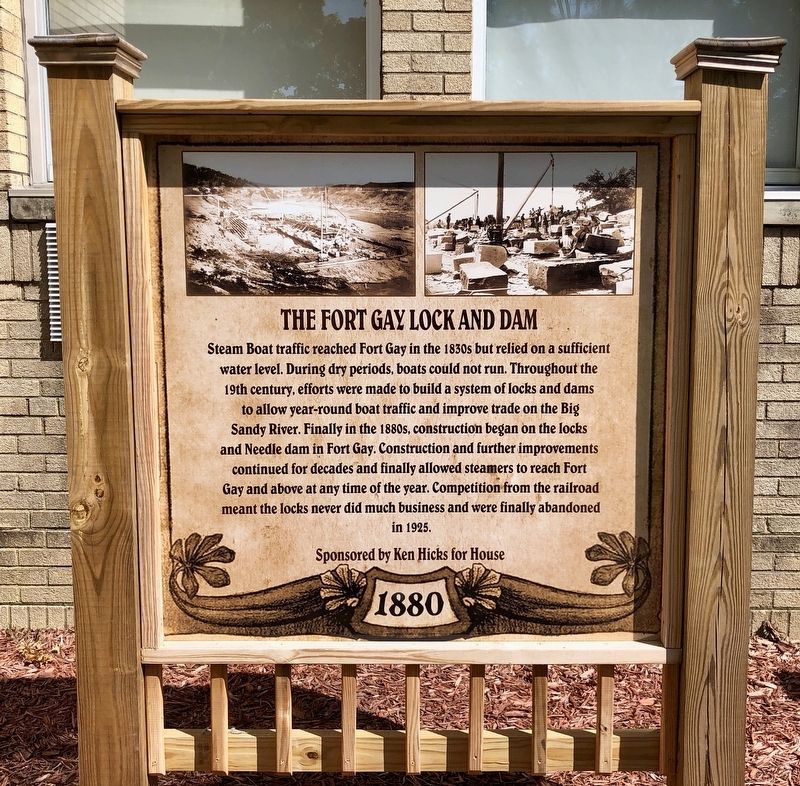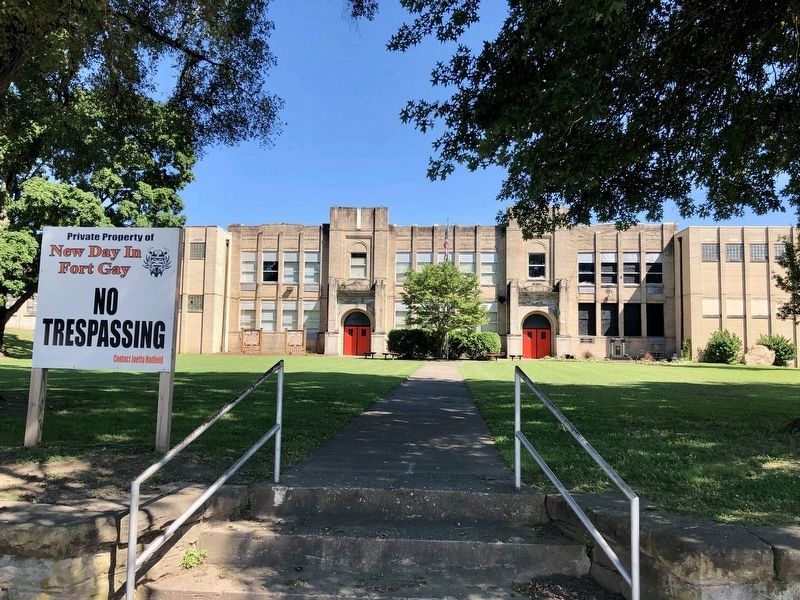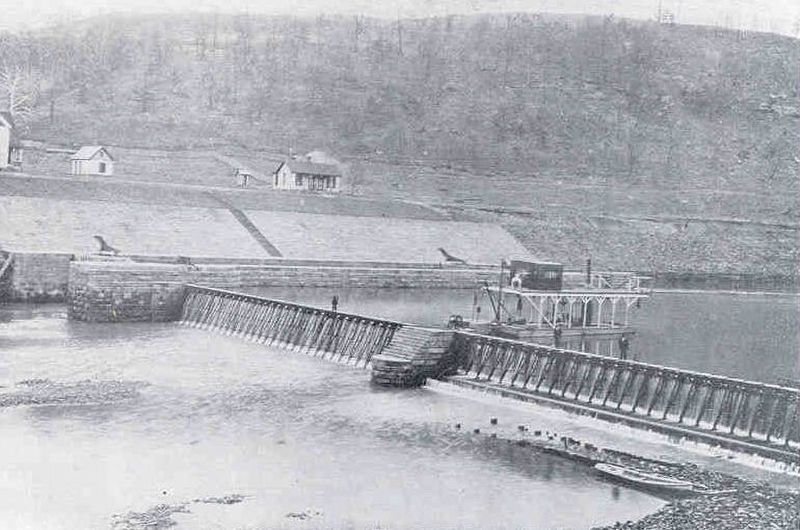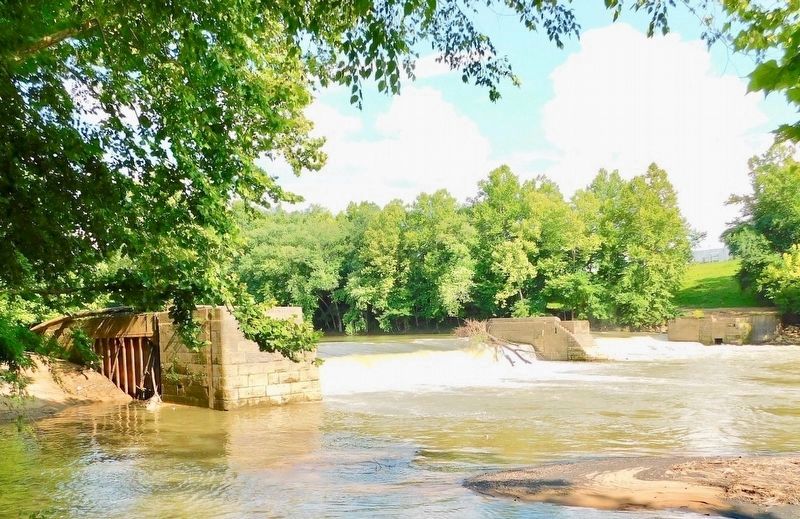Fort Gay in Wayne County, West Virginia — The American South (Appalachia)
The Fort Gay Lock and Dam
1880
Erected by Ken Hicks for House.
Topics. This historical marker is listed in this topic list: Waterways & Vessels. A significant historical year for this entry is 1925.
Location. 38° 7.015′ N, 82° 35.625′ W. Marker is in Fort Gay, West Virginia, in Wayne County. Marker is on Court Street (West Virginia Route 37) east of Vancouver Street, on the right when traveling east. Touch for map. Marker is at or near this postal address: Court Street, Fort Gay WV 25514, United States of America. Touch for directions.
Other nearby markers. At least 8 other markers are within walking distance of this marker. Fort Gay Toll Bridge (here, next to this marker); Fort Gay (within shouting distance of this marker); Frederick M. Vinson (approx. 0.4 miles away in Kentucky); Lawrence County Veterans Memorial (approx. half a mile away in Kentucky); County Named, 1821 (approx. half a mile away in Kentucky); Old Floyd County / Lawrence County Revolutionary War Memorial (approx. half a mile away in Kentucky); Vancouver’s Fort (approx. half a mile away in Kentucky); Louisa in Civil War (approx. half a mile away in Kentucky). Touch for a list and map of all markers in Fort Gay.
Regarding The Fort Gay Lock and Dam. History of the Fort Gay Lock and Dam by Robert Thompson
1835 – The first survey of the river for boat traffic is made
1838 – The first steamboats have reached Fort Gay by this time
1849 – Frederick Moore built a wharf on the river at Fort Gay for loading and unloading goods
1858 – The Big Sandy River Navigation Company was established to build locks but never did.
1875 – US Army Corps of Engineers conducts a study of the river for improvement of transportation
1878 – Army Corps of Engineers begins removing debris and overhanging trees to improve navigation
1880 – Federal government approves construction of a lock and dam at Fort Gay
1883 – Construction
begins on the lock and dam led by Engineer B.F. Thomas. Workers began coming into town to work on the project.
1885-1888 – The lock and dam project routinely suffers from delays and cost overruns. Construction season occurred during dry months in the summer.
1891 – The project is altered to allow for construction of a moveable needle dam instead of a fixed dam at Fort Gay. It would be the first in the US.
1890s – Plans expanded to include additional locks and dams along the Big Sandy, Tug and Levisa. They were completed at Kenova, Prichard and Saltpeter.
1893 – 125 men were at work on the Fort Gay structure
1895 – Total cost for the Fort Gay lock and dam reached $750,000.
1897 – Initial construction was completed on the Fort Gay lock. Engineers from Mississippi and Hungary visit. The Congressional River and Harbor Committee visits. Elevent additional locks are planned on the Levisa Fork and eight on the Tug Fork. The total system of locks and dams on the Big Sandy and tributaries consisted of twenty-two structures. Most were never finished.
1902 – Federal government approves raising the height of the Fort Gay lock. Transportation through the lock dropped from 300,000 tons to 194,000 tons.
1904 – Locks and Kenova and Prichard are completed allowing year-round river traffic to Fort Gay.
1908 – Fort Gay lock is shutdown to allow for raising its height and installing steel gates.1909 – Lock and dam at Saltpeter is completed.
1912 – Engineer B.F. Thomas leaves his position on the Big Sandy.
1920 – The Fort Gay lock was operating at reduced capacity while repairs were ongoing.
1922 – A small amount of coal and oil is transported through the lock at Fort Gay
1925 – Federal government decides to abandon the locks on the Big Sandy River.
1940 – Army Corps of Engineers issued a report looking into building new modern locks and dams on the Big Sandy. It never occurred.
Credits. This page was last revised on July 30, 2019. It was originally submitted on July 30, 2019, by Mark Hilton of Montgomery, Alabama. This page has been viewed 741 times since then and 67 times this year. Photos: 1, 2, 3, 4, 5. submitted on July 30, 2019, by Mark Hilton of Montgomery, Alabama.




